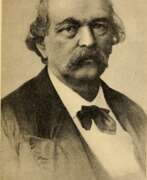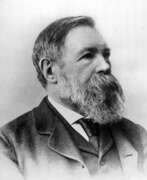Philosophers 19th century


Bernard Bolzano, full name Bernard Placidus Johann Nepomuk Bolzano, was an Italian-born Czech scientist, mathematician, logician, philosopher and theologian.
Bolzano graduated from the University of Prague and was immediately appointed professor of philosophy and religion at the university. Within a few years, however, Bolzano had already shown himself to be a free thinker with his teachings on the social costs of militarism and the needlessness of war. He called for a complete reform of the educational, social, and economic systems that would direct the nation's interests toward peace rather than armed conflict between states. In 1819, Bolzano was expelled from the university for his beliefs and thereafter turned his full attention to works on social, religious, philosophical, and mathematical issues.
Bolzano held advanced views on logic, mathematical quantities, limits, and continuity. He is the author of the first rigorous theory of real numbers and one of the founders of set theory. In his studies of the physical aspects of force, space, and time, he proposed theories opposed to those advanced by the German philosopher Immanuel Kant. His contributions to logic, in particular, established his reputation as the greatest logician of his time. Much of his work remained unpublished during his lifetime and was not widely disseminated until the late nineteenth and early twentieth centuries, when a number of his conclusions were reached independently.
Bolzano was multi-talented in various fields of science to which he made significant contributions. His published works include The Binomial Theorem (1816), A Purely Analytic Proof (1817), The Functional Model and the Scientific Model (1834), An Attempt at a New Statement of Logic (1837), and The Paradoxes of Infinity (1851).
Among other things, Bolzano was also a great philanthropist. Together with his friends and students, he supported the activities of almshouses, homes for the blind, loan banks for the working class, libraries, and elementary schools in rural areas.


Mathurin Jacques Brisson was a French zoologist, ornithologist, naturalist and physicist, a member of the Academy of Sciences.
He is known for his published works in natural history: Le Règne animal ("The Kingdom of Animals", 1756) and Ornithologie ("Ornithology", 1760), in which he described 1,500 species of birds grouped into 115 genera, twenty-six orders, and two classes. Brisson was one of the first to come close to the concept of "type" in zoology, although he does not use the term, but his classification was used for about 100 years. He translated a number of important books on zoology for his time into French.
Brisson's works in physics are related to the measurement of specific gravity of various bodies, the study of gases and refraction of light, mirrors, magnetism, atmospheric electricity, and barometers.


John Cartwright was an English naval officer, Nottinghamshire militia major and prominent campaigner for parliamentary reform. He subsequently became known as the Father of Reform. His younger brother Edmund Cartwright became famous as the inventor of the power loom.
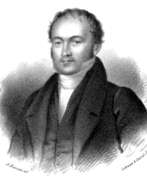

Lewis David de Schweinitz (also Ludwig David von Schweinitz), born on February 13, 1780, in Bethlehem, Pennsylvania, was a German-American botanist and mycologist. His parents, Hans Christian Alexander and Dorothea Elizabeth von Watteville von Schweinitz, were instrumental in the administration of the Moravian Church in America. Following his early education in Bethlehem, Schweinitz was sent to Germany in 1798 to continue his academic pursuits.
In Germany, Schweinitz enrolled in the Moravian Theological Seminary at Niesky in Silesia. It was there that he met Professor Albertini, who shared his interest in botany. Schweinitz's focus on the study of fungi earned him the title "Father of North American Mycology." His contributions to the field were significant, as he was the first American to concentrate his botanical efforts specifically on fungi.
Among his many accomplishments, Schweinitz produced extensive mycological illustrations and published works on the subject. His manuscripts and watercolor paintings of fungi served as reference materials in the development of his Conspectus, a compendium of his findings and classifications. The impact of his work was so considerable that several taxa were named in his honor, highlighting his legacy in the world of botany and mycology.
Schweinitz passed away on February 8, 1834, but his legacy endures through his scientific contributions and the respect he garnered internationally as a botanist. His life and work continue to be celebrated and studied by those in the field, and his illustrations and findings remain a significant part of mycological history.


Lewis Carroll, real name Charles Lutwidge Dodgson, was a British writer and photographer, philosopher and logician, and professor of mathematics.
In 1851 Lewis entered one of the best colleges in Oxford - Christ Church. Showing an extraordinary aptitude for mathematics, soon he was able to give lectures himself, and for the next quarter of a century he was a professor of mathematics at Oxford. In parallel with his studies, the young man began to compose short stories and poems, publishing them under a pseudonym.
And then he wrote the famous "Alice's Adventures in Wonderland" (Alice's Adventures in Wonderland, 1865) and "Alice in Looking-Glass" (Through the Looking-Glass, and What Alice Found There, 1871). These books quickly became popular, they were translated into numerous languages, and then repeatedly screened. The prototype of the main character was four-year-old Alice Liddell, the daughter of the new dean of the college where Carroll taught. Lewis Carroll also wrote "The Knotty Story", a humorous poem "Hunting the Snark", "Mathematical Curiosities", "Sylvia and Bruno" and other books. Carroll himself considered his main work a slightly absurd novel-tale "Sylvia and Bruno" (1889-1893).
Under his real name, the writer-mathematician published scientific works on mathematics and logic, he also owns a number of popular books on entertaining mathematics. Lewis Carroll left Oxford only once - in 1867, visiting Russia as part of a delegation of the Anglican Church on the route St. Petersburg-Moscow-Nizhny Novgorod. This was Carroll's only overseas trip, and he described it in his Diary of a Trip to Russia 1867. Lewis Carroll was also a talented chess player and amateur inventor. Photography was also a big part of the writer's life.


Ralph Waldo Emerson was an American philosopher, lecturer and poet, one of the most prominent thinkers and writers in the United States, and the originator of transcendentalism.
Ralph studied at Boston State Latin School and then at Harvard College (later Harvard University), began to preach, but soon doubted his chosen path and resigned his ministry. Emerson went to Europe, where new acquaintances and knowledge led him to new thoughts, and, returning to the United States in 1833, he began writing his famous book "Nature", where he first formulated a philosophy called transcendentalism. Soon other thinkers rallied around him, forming a group of like-minded thinkers.
In the essay "Nature," published in 1836, and in the following works, "The American Scholar" and "An Address in the School of Theology," Emerson consistently developed his ideas. Emerson's doctrine of the self-sufficiency and self-reliance of the individual stems from his view that a person need only look into his own heart to receive the spiritual guidance that has hitherto been the prerogative of the official churches. One must then have the courage to be oneself and trust the inner power within oneself, living one's life according to the commandments one has intuitively derived. These thoughts are not new, but Emerson put them in imaginative and accessible language.
Emerson's speeches led to his being ostracized at Harvard for many years. However, the informal Transcendental Club, founded in 1836, was joined and supported by his young students. The world fame of the brilliant thinker Emerson brought his "Essays" in two volumes, published in 1841 and 1844. As the main representative of transcendentalism, Emerson gave direction to the religious, philosophical and ethical movement, which above all emphasized belief in the spiritual potential of each person.
A later work of confession, The Conduct of Life (1860), demonstrates the author's developed humanism and full awareness of human limitations. The voluminous collection of poems cemented Emerson's reputation as a major American poet.


Pedro Figari was a Uruguayan painter, lawyer, writer, and politician. Although he did not begin the practice until his later years, he is best known as an early modernist painter who emphasized capturing the everyday aspects of life in his work. In most of his pieces, he attempts to capture the essence of his home by painting local customs that he had observed in his childhood.
Figari painted primarily from memory, a technique that gives his work a far more personal feeling. With his unique style, which involved painting without the intention to create an illusion, he, along with other prominent Latin-American artists such as Diego Rivera and Tarsila do Amaral, sparked a revolution of identity in the art world of Latin America.


Albert Gleizes was a pioneering French artist, theoretician, and philosopher, renowned for his contributions to Cubism and his influence on the School of Paris. Born in Paris in 1881, Gleizes' artistic journey began in his late teens, inspired by Impressionism and later evolving through Post-Impressionist and Symbolist phases. His early work, such as "La Seine à Asnières" exhibited in 1902, showcases his initial foray into painting. Gleizes' commitment to developing art free from commercial constraints led him to co-found the Abbaye de Créteil, a self-supporting artist community, although it was short-lived due to financial difficulties.
Gleizes' exploration of Cubism began around 1910, in collaboration with artists like Jean Metzinger, with whom he wrote "Du Cubisme," the first major treatise on the movement. This period marked a significant shift in his style towards the geometric simplification of forms, a hallmark of Cubism. His works from this era, including "Portrait de Jacques Nayral" and "Landschaft bei Paris," exemplify his innovative approach to capturing the essence of subjects through cubist principles. Gleizes was also a member of the Section d'Or group, further establishing his role in the Cubist movement.
In addition to his painting, Gleizes was deeply involved in writing and promoting Cubism, influencing the acceptance and understanding of modern art globally, including his significant impact in New York. His later works, such as "Pour Contemplation," reflect a spiritual and theological depth, moving towards a synthesis of the physical and metaphysical. Gleizes' art is celebrated for its revolutionary approach to form and color, contributing significantly to the development of modern art. His works are held in prestigious collections worldwide, including the Tate Modern and the Musée des Beaux-Arts in Lyon.
For those intrigued by the revolutionary spirit and profound impact of Albert Gleizes on modern art, signing up for updates on new product sales and auction events related to his work offers a unique opportunity to connect with the legacy of this Cubist master. This subscription is an invaluable resource for collectors and experts in art and antiques, promising exclusive insights into the world of Albert Gleizes.
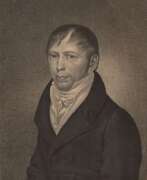

Friedrich Gottlob Hayne was a German botanist, taxonomist, pharmacist and professor.
After many years of teaching, he was appointed Professor of Pharmaceutical Botany in 1828. In addition to his lecturing duties he led many botanical excursions. He was known for using precise terminology in his plant descriptions.


Anne-Louise-Germaine Necker, Baroness of Staël-Holstein, known as Madame de Staël, was a French writer, literary theorist, and publicist.
She was born into a Swiss family where her father was a banker and then finance minister to King Louis XVI, and her mother ran a brilliant literary and political salon in Paris where Voltaire, Diderot, and Hume frequented. Young Necker received a brilliant education, she absorbed the intellectual environment with great curiosity, becoming a witty and well-read conversationalist.
In 1786, she married the Swedish ambassador to Paris, Baron Eric de Staël-Holstein. It was a marriage of convenience, which ended in 1797 formal divorce.
Madame de Staël became known not only for her stunning and versatile works, but also for her enormous influence on the intellectual climate of that 19th century. During her lifetime she was known as a novelist, but she became much more famous as a political philosopher, literary critic, and theorist of Romanticism. Madame de Staël was an implacable opponent of Napoleon I and traveled around Europe for a decade during his reign from 1803. In 1810, the writer published one of her most famous and influential works, On Germany. She returned to Paris in 1814, after the fall of Napoleon, and wrote "Reflections on the Principal Events of the French Revolution."
In her travels, Madame de Staël met many politicians, artists and writers and was known for her cosmopolitanism and feminism. Madame de Staël epitomized the European culture of her time, combining ideas from neoclassicism to romanticism in her glittering salon for leading intellectuals.


Kazimir Severinovich Malevich (Russian: Казимир Северинович Малевич) was a pioneering Russian artist, known for his profound influence on the development of abstract art in the 20th century. His nationality and specializations in painting, art theory, and teaching have cemented his place as a pivotal figure in the avant-garde movement, particularly for his role in founding the Suprematism movement. This movement, characterized by its focus on basic geometric shapes and a limited color palette, aimed to convey the supremacy of pure artistic feeling over the depiction of objects.
Malevich's art and theories have had a lasting impact on the course of modern art, challenging traditional perceptions of form and composition. His most famous work, "Black Square," epitomizes the essence of Suprematism. It represents a radical break from past art forms and a move towards abstraction, where the emotional and spiritual dimensions of art are prioritized. This piece, along with others like "White on White," has been exhibited in prestigious museums and galleries worldwide, showcasing Malevich's enduring legacy.
For collectors and experts in art and antiques, Malevich's works are not just paintings but are significant historical artifacts that embody a transformative period in art history. His contributions extend beyond his canvases, influencing sculpture, culture, and the broader artist school. His innovative approach to art has paved the way for future generations of artists, making his works highly sought after in the art and antique collecting community.
For those interested in the avant-garde movement and the evolution of abstract art, staying informed about Kazimir Malevich's contributions is essential. We invite you to sign up for updates related to Malevich, including notifications on new product sales and auction events. This subscription will keep you at the forefront of the latest discoveries and opportunities to acquire pieces connected to this revolutionary artist.


Karl Marx, full name Karl Heinrich Marx, was a German philosopher, sociologist, historian and economist, social activist, and journalist. One of the most significant political figures in the world, his works have had a great influence on the course of human history.
Karl Heinrich Marx was born into a large Jewish family of rabbinic dynasty, but his father and Karl himself were baptized. The young Karl received a liberal arts education at the University of Bonn and the University of Berlin and was actively involved in the turbulent political life of Germany and France in the 19th century. For his political activities in 1849 he was expelled from Germany, moved with his family to Paris and then to London, where he lived and worked until the end of his life.
In 1844 he met the German socialist Friedrich Engels, who became his friend and collaborator for the rest of his life. Together they had already published the Manifesto of the Communist Party (1848), the most famous pamphlet in the history of the socialist movement. Karl Marx was also the author of the movement's most important book, Das Kapital (Capital). These and other writings of Marx and Engels formed the basis of the system of views and beliefs known as Marxism.
Marx examined the very different versions of socialism that existed in the early nineteenth century and combined them into a doctrine that remained the dominant version of socialism for half a century after his death. His emphasis on the influence of economic structure on historical development was of enduring importance.


Giovanni Vincenzo Petrini was an Italian priest and theologian, philosopher, mathematician, and expert in mineralogy.
Along with Scipio Breislacus, Petrini was one of the founders of Italian volcanology. He taught philosophy and mathematics, theology, but specialized in mineralogy and created the Mineralogical Cabinet in Nazareth. This museum was famous in Europe and was visited, among others, by Emperor Joseph II, who gave him rare specimens from the lands of the Empire and especially from Hungary.
Giovanni Petrini was the author of the catalog Gabinetto mineralogico del Collegio Nazareno ("The Mineralogical Cabinet of the Nazarene Collegium, described by external features and distributed by component parts" (Rome, 1791-1792). The specimens in it are classified according to a standard structure: salts, earths, bitumens, combustibles, and metals. There is also a section on gemstones.


Nikolai Konstantinovich Roerich (Russian: Никола́й Константи́нович Ре́рих) was a distinguished Russian artist, writer, archaeologist, and philosopher, renowned for his profound contributions to culture and art. His multifaceted career spanned various disciplines, but it was his exceptional talent in painting that immortalized his name among the greats. Roerich's art is celebrated for its mystical and symbolic themes, often drawing inspiration from Russian folklore, religion, and his own spiritual quests. His dedication to cultural preservation and peace through art led to the establishment of the Roerich Pact, a treaty advocating for the protection of cultural heritage.
Roerich's paintings are characterized by vibrant colors and intricate details, capturing the ethereal beauty of landscapes and mythical scenes. His works, such as "Madonna Laboris" and the series "Sancta," are revered for their spiritual depth and artistic excellence. These masterpieces can be found in prestigious museums and galleries worldwide, serving as testaments to Roerich's enduring legacy in the art world. His commitment to integrating spiritual and cultural dimensions in his art has made him a seminal figure for collectors and experts in art and antiques.
Roerich's influence extends beyond his paintings; his philosophical writings and cultural initiatives have also left a significant mark on the fields of art and heritage preservation. As enthusiasts of art and antiquities continue to explore Roerich's rich legacy, there is a growing appreciation for his vision of unity and harmony through cultural expression. For those captivated by Roerich's remarkable life and works, signing up for updates is an invaluable opportunity to stay informed about new product sales and auction events dedicated to his art. This subscription is a gateway to exclusive insights and offerings that celebrate the legacy of Nikolai Konstantinovich Roerich, ensuring enthusiasts remain connected to the evolving exploration of his profound contributions.


Karl Ludwig Rosenfelder was a German painter of the mid-nineteenth century. He is known as a painter, graphic artist, educator, and philosopher.
Rosenfelder specialized in religious and historical paintings, including large-scale paintings of medieval subjects. He also participated in the creation of wall paintings at the University of Königsberg, which earned him an honorary doctorate.
Rosenfelder was one of the founders of the Association of Berlin Artists in 1841, and in 1845 he became the founder and director of the Königsberg Art Academy, a position he held until 1874.


John Ruskin was an English philosopher, art historian, and polymath of the Victorian era, celebrated for his profound influence on art, architecture, and society. With a diverse array of interests ranging from geology to literature, John Ruskin's contributions to the cultural and intellectual fabric of the 19th century were unparalleled. His notable works include "Modern Painters," "The Seven Lamps of Architecture," and "The Stones of Venice," where he explored the deep connections between nature, art, and society. Ruskin's advocacy for the Pre-Raphaelites and his critical stance against industrialization's impact on art and architecture marked him as a pivotal figure in the Arts and Crafts Movement. His teachings inspired generations, including William Morris, to value craftsmanship over mass production, anticipating modern concerns with environmentalism and sustainability.
John Ruskin's early life, shaped by his parents' influence and his exposure to the art and religious fervor of his time, laid the foundation for his later views that championed a return to nature and the importance of truth in art. His critical writings, not just limited to art but extending to social criticism, embodied a vision for societal reform that emphasized ethics, aesthetics, and the human connection to the natural world. John Ruskin's legacy is reflected in his ability to inspire both contemporaries and future movements, highlighting his role as a visionary thinker whose ideas transcended the boundaries of his time.
For collectors and experts in art and antiques, John Ruskin's life and work offer a rich tapestry of insights into the Victorian era's cultural and aesthetic debates. His profound impact on art criticism, architectural theory, and social philosophy makes him a figure of enduring significance in the history of art and culture.
To stay informed about new product sales and auction events related to John Ruskin, sign up for updates. This subscription is a gateway to exploring the legacy and continued relevance of one of the most influential figures in the world of art and culture.
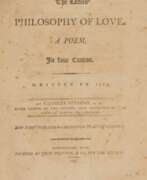

Charles Stearns was an American clergyman and doctor of philosophy.
Rev. Charles Stearns graduated from Harvard College and served the Congregational Church in Lincoln from late 1781 until his death. Several of his sermons were printed in the early 19th century.
In addition, Stearns was principal of the Liberal School, which opened in early 1793, a relatively progressive coeducational institution. While working at the school, Stearns wrote and published a number of works related to education, including Dramatic Dialogues for the Use of Schools (1798), a collection of thirty original plays that were performed by students.


Rabindranath Tagore was a South Asian Bengali polymath who worked as a poet, writer, playwright, composer, philosopher, social reformer and painter. He reshaped Bengali literature and music as well as Indian art with Contextual Modernism in the late 19th and early 20th centuries. Author of the "profoundly sensitive, fresh and beautiful" poetry of Gitanjali, he became in 1913 the first non-European and the first lyricist to win the Nobel Prize in Literature. Tagore's poetic songs were viewed as spiritual and mercurial; however, his "elegant prose and magical poetry" remain largely unknown outside Bengal. He was a fellow of the Royal Asiatic Society. Referred to as "the Bard of Bengal", Tagore was known by sobriquets: Gurudev, Kobiguru, Biswakobi.


Henry David Thoreau is an American writer and poet, philosopher and publicist. He was a prominent representative of American transcendentalism, a friend and associate of Ralph Waldo Emerson.
Henry studied at Harvard University, where he met Ralph Waldo Emerson, the future founder of American Transcendentalism. Thoreau saw Emerson as a guide, a father and a friend. Under his guidance, Henry began to publish his poems and essays with increasing confidence.
In the early spring of 1845, the 27-year-old Thoreau began a new life: he chipped a cabin for himself on the shore of Walden Pond, ate very moderately and meditated. He also read and wrote "A Week on the Concord and Merrimack Rivers," then published in 1849. What eventually emerged was a series of 18 essays called "Walden," describing Thoreau's experimentation with the basics of life. Thoreau's clear and elegant style of presentation brought this work to the level of a literary classic.
Thoreau lived according to the doctrines of transcendentalism recorded in his masterpiece Walden (1854) for two years, and then left the cabin. But life around him had already changed, and little by little his moods began to change as well. Thoreau began to move away from transcendentalism, became more involved in public life, and became a committed abolitionist.
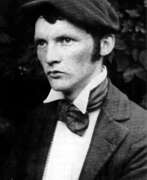

Heinrich Vogeler was a German artist and philosopher, a representative of the German Art Nouveau. A versatile and talented artist, he painted, watercolored, composed poems, designed, designed and decorated. Over time, his style of art changed over a wide range.
During World War I, from 1914 to 1917, Vogeler was on the Eastern Front as a volunteer and made sketches, which resulted in his pacifist sentiments.
In the mid-1920s he visited the Soviet Union several times and his impressions resulted in paintings in his own "complex style: "Karelia and Murmansk" (1926), "Building a New Life in the Soviet Republics of Central Asia" (1927), and "Baku" (1927). In 1931 Vogeler received an invitation to work in the USSR. The coming to power of the Nazis in Germany made it impossible for him to return home, and after Hitler's invasion Vogeler among many was deported to the Kazakh SSR, where he died.


Johann Wolfgang von Goethe, a German polymath and writer, is celebrated as one of the most influential figures in the German language and Western culture. His vast array of works spans poetry, novels, plays, and scientific writings, reflecting his diverse interests and profound impact on various fields.
Goethe's early life in Frankfurt laid the foundation for his diverse interests. After studying law, he gained fame with "The Sorrows of Young Werther," which led to an invitation to the Weimar court. His contributions there were significant, including roles in the ducal council, mining supervision, and cultural endeavors like theater management and the botanical park's planning.
His literary achievements are vast, with notable works like "Faust" and "Wilhelm Meister's Apprenticeship," which delve into human nature and societal reflections. Goethe's "Sturm und Drang" period was marked by intense emotion and a break from traditional forms, influencing subsequent cultural movements.
Johann Wolfgang von Goethe's interest in science is equally noteworthy. He made contributions to biology, zoology, and color theory, advocating for a holistic view of nature and expressing skepticism toward restrictive scientific methodologies. His works in these areas reflect a deep desire to understand and articulate the natural world's interconnectedness.
For art collectors and experts, Goethe's influence extends beyond his literary and scientific contributions. His role in Weimar Classicism and his artistic endeavors offer rich insights into the period's cultural landscape, providing a multifaceted perspective on his legacy.
To stay informed about developments and events related to Johann Wolfgang von Goethe, consider signing up for updates. This subscription will keep you informed about new product sales and auction events related to Goethe's works and influence, offering exclusive insights for enthusiasts and collectors.


Julia Ward Howe is an American writer and poet, philosopher, abolitionist, and feminist.
Born into a well-to-do family and privately educated, Julia Ward married educator Samuel Gridley Howe and settled in Boston. She published her first collection of poems, Passionate Flowers, in 1854.Julia's early poems were praised by Hawthorne, Whittier, and Longfellow for their intellectual intensity. For a time Howe published the abolitionist newspaper Commonwealth with her husband. And in February 1862, The Atlantic Monthly published her poem "Battle Hymn of the Republic," which became the semi-official Civil War song of the Union Army, and Howe gained fame.
After the war, Howe began fighting for women's rights. In 1868, she was elected the first president of the New England Women's Suffrage Association. In 1868, she helped found the New England Woman's Club and became its president in 1871, the same year she became the first president of the American branch of the International Women's Peace Association. She was later active in the International Federation of Women's Clubs. Howe continued to write throughout her life, publishing travel books, poems, collections of essays, and biographies.
In 1870, she co-founded Woman's Journal and then served as its editor for 20 years. She traveled extensively until her advanced old age. In 1908, she became the first woman elected to the American Academy of Arts and Letters.


Oscar Fingal O'Flahertie Wills Wilde - Irish writer, poet, philosopher and playwright, a bright representative of the literature of the Victorian period.
Oscar's parents were fond of literature and history, gave their son an excellent education. After graduating from Oxford University, Oscar moved to London, where he quickly entered the circle of secular society. His first book, a collection of poems, was published in 1881. Over the next year, the aspiring writer traveled across America with lectures on art. Then he traveled to France, where he met key figures of French literature of the time - Victor Hugo, Paul Verlaine, Emile Zola and others. Returning to his homeland, Oscar married, thanks to which his children's fairy tales appeared. His popularity grew rapidly, his work was favorably reviewed by Bernard Shaw.
Next, "The Crime of Lord Arthur Seville", "The Canterville Ghost", "The Sphinx without a riddle" were written. In 1890 Oscar Wilde wrote the novel "The Portrait of Dorian Gray", which was considered immoral in high society, but it brought the author the greatest fame. This novel is still considered a classic of world literature to this day. In the early 1890s Oscar Wilde wrote comedy plays "Lady Windermere's Fan", "A Woman Not Worth Watching", "An Ideal Husband" and "How Important It Is to Be Serious". In them, the author shows himself a master of witty dialog. During his life, Wilde wrote nine plays, one novel, many poems, stories and essays.
Bright and full life of a successful and talented writer ended when he met Lord Alfred Douglas. For this scandalous connection with the man, Oscar Wilde was sentenced to two years in prison. After leaving prison, he settled in France under an assumed name, abandoned by everyone. He wrote his last work, the autobiographical "Ballad of Reading Prison" two years before his death at the age of 46.


